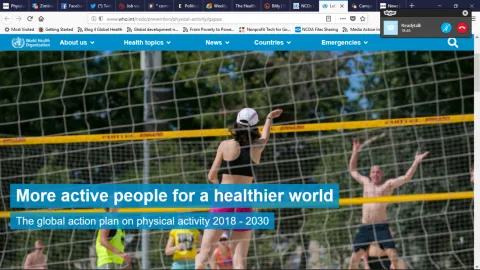Physical activity in Latin America: new WHO plan and industry interference

A recent webinar by the Healthy Latin American Coalition (CLAS) presented the new WHO global plan for physical activity, a mapping of stakeholders working in 13 countries, and discussed how the ultra-processed foods and beverage industries finance activities to thwart anti-obesity policies.
Fiona Bull from the WHO presented the 4 objectives and 20 main actions proposed in the new Global Action Plan for Physical Activity: More active people for a healthier world (GAPPA).
Improving environments is key
A set of 20 regulatory measures in the GAPPA aim to reduce physical inactivity in adults and adolescents by 15% by 2030. Improving environments and opportunities so that people of all ages and abilities can dedicate more time to physical activity will be key to reaching that goal, explained Bull.
She also linked the success of that objective to 13 sustainable development goals (SDGs), highlighting the multiple health, social and economic benefits of an active society. Finally, Bull analysed the next steps for effective implementation of WHO’s new "Let's be active" campaign.
Other speakers during the webinar included:
- Gabriela Lozano and Guillermo Crespo, from the Inter-American Heart Foundation Argentina (FIC Argentina);
- Luis Fernando Gómez, of Fundación FES Social and,
- Beatriz Champagne of the InterAmerican Heart Foundation (IAHF), as moderator.
The FIC Argentina speakers presented a regional mapping of stakeholders interested in the promotion of physical activity, created through a survey involving 13 countries. The aims of the exercise were to kick-start future collaboration, exchange information and promote public policies.
National physical activity plans
The mapping showed various inconsistencies between countries regarding knowledge of national physical activity plans. It also registered the types of existing programmes (research, interventions, incidence and strategies), and the main interests of organisations linked to physical activity, such as NCD control, policy implementation or changing unhealthy behaviours.
Finally, Luis Fernando Gómez from FES Social, reflected on how the financing of academic groups by the ultra-processed food and beverage industry interferes with implementation of policies to prevent obesity.
Co-optation of researchers and the financing of projects, as well as deceptive campaigns aimed at delinking the risk of consuming unhealthy products to current serious health problems, were tactics used by the industry, explained Gómez.